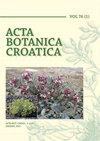Leaf phenotypic plasticity of European ash (Fraxinus excelsior) at its northern range in Dinaric Alps
IF 1.1
4区 生物学
Q3 PLANT SCIENCES
引用次数: 0
Abstract
The Dinaric Alps have been recognised on numerous occasions as a biodiversity hotspot. They host a variety of species with great importance in sustainable forestry operations and nature conservation. One such species is the European ash (Fraxinus excelsior L., Oleaceae), a broad-leaved, wind-pollinated and wind-dispersed forest tree. In this paper, we aimed to determine the morphological variability of the European ash populations of the northern Dinaric Alps. For this purpose, leaf samples from 10 individuals in seven populations were collected. Morphometric analysis of intra- and interpopulation variability was conducted using 19 morphological leaf traits. We determined great variability of trees within, and small variability among, populations. The variables that best discriminated studied populations were those relating to leaflet shape. Based on these variables, populations were grouped into two clusters. The first cluster encompassed individuals with acute leaflets, found in drier and rockier habitats, whereas the second cluster, defined by more rounded leaflets, was found in mesophilous and nutrient-rich habitats. However, this research revealed no influence of geographical or bioclimatic distances on morphological variability, which indicates that the rockiness and soil are most likely two predominant factors in shaping the phenotypic plasticity of European ash populations. These results are of great significance in the planning of future forest breeding programs, as populations from drier habitats are likely to persist and spread due to their adaptation to water scarcity, which will become more pronounced in the future.欧洲白蜡树(Fraxinusexcelsior)在迪纳拉阿尔卑斯山北部分布区的叶片表型可塑性
第纳尔阿尔卑斯山多次被确认为生物多样性热点地区。在可持续林业运营和自然保护方面,它们拥有多种极为重要的物种。欧洲白蜡(Fraxinus excelsior L.,油桐科)就是其中的一种,它是一种阔叶树,随风授粉,随风飘散。本文旨在确定迪纳拉阿尔卑斯山北部欧洲白蜡种群的形态变异性。为此,我们收集了七个种群中 10 个个体的叶片样本。我们使用 19 种叶片形态特征对种群内和种群间的变异性进行了形态计量分析。我们发现树木在种群内的变异性很大,而在种群间的变异性很小。最能区分所研究种群的变量是与小叶形状有关的变量。根据这些变量,种群被分为两组。第一组包括小叶尖锐的个体,分布在较干燥和岩石较多的生境中,而第二组是小叶较圆的个体,分布在中温带和营养丰富的生境中。不过,这项研究没有发现地理或生物气候距离对形态变异的影响,这表明岩石和土壤很可能是影响欧洲白蜡种群表型可塑性的两个主要因素。这些结果对未来森林育种计划的规划具有重要意义,因为来自较干旱栖息地的种群很可能因适应缺水而持续存在并扩散,而缺水问题在未来将变得更加突出。
本文章由计算机程序翻译,如有差异,请以英文原文为准。
求助全文
约1分钟内获得全文
求助全文
来源期刊

Acta Botanica Croatica
PLANT SCIENCES-
CiteScore
2.50
自引率
0.00%
发文量
34
审稿时长
>12 weeks
期刊介绍:
The interest of the journal is field (terrestrial and aquatic) and experimental botany (including microorganisms, plant viruses, bacteria, unicellular algae), from subcellular level to ecosystems. The attention of the Journal is aimed to the research of karstic areas of the southern Europe, karstic waters and the Adriatic Sea (Mediterranean).
文献相关原料
| 公司名称 | 产品信息 | 采购帮参考价格 |
|---|
 求助内容:
求助内容: 应助结果提醒方式:
应助结果提醒方式:


